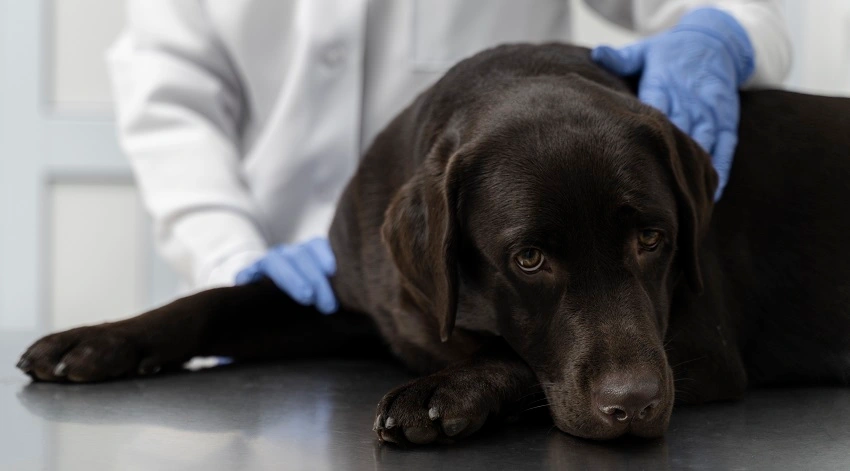How To Help A Dog With Seizures: 7 Proven Remedies
Canine seizures are scary. Pet owners often panic the first time it happens to their dogs. While it’s an understandable reaction, there’s always a way on how to help a dog with seizures. You can also perform some steps to prevent it from happening again. Below, I discussed what triggers seizures in dogs and what you can do about it.
What can trigger a seizure in a dog?


Canine epilepsy can be triggered due to various reasons. The following are the most common culprits behind this health problem:
- Genetics. Idiopathic epilepsy is a genetic condition that canines inherit from their parents. The actual cause for this isn’t established, but veterinarians can help identify potential triggers.
- Low blood sugar. Low blood sugar or hypoglycemia occurs when a dog isn’t fed for long hours. Puppies and small breeds are prone to this condition. Aside from that, metabolic issues can also trigger low blood sugar levels.
- Brain trauma. Brain trauma in dogs can occur when a dog falls or gets hit with an intense impact. This can cause brain trauma that will trigger seizures and long-term injuries.
- Blood abnormalities. Low electrolyte levels, infection, and blood diseases can also lead to seizures. It’s important to have your dog checked as this problem can only be determined through lab work.
- Poisoning. A dog that has been exposed to a toxic substance will experience seizures. This can happen even if your pet is healthy. The toxic substance can mess with your dog’s blood pressure and internal organs that leads to seizures.
A dog seizure is multi-faceted, which means it can be triggered by other conditions not mentioned here. Remember that your dog’s vet is always the best person to consult.
What do you do when your dog is having a seizure?
If your dog suddenly twitches, loses consciousness, experiences focal seizure, and behaves erratically, it might be having a grand mal seizure. One thing you should never do is try to hug or hold the dog during the attack.
Instead, you should do the following: Please read here why is my dog acting paranoid all of a sudden

1. Time the seizure episode
There’s no way you can stop your dog’s seizure once it starts happening. Instead of panicking, you must time the duration of the seizure. This will give the vet a better understanding of what happened and the potential extent of damages that occurred on your pet’s brain.
If you can, try to film the seizure so that you can show it to the vet. This will let the vet assess the situation further. However, if your phone isn’t accessible, just remember key aspects of the attack. Note if your dog is drooling, hanging its tongue out, and exhibiting seizure activity that may help with the diagnosis.
2. Don’t try to grab your dog’s tongue
There’s a common misconception that animals swallow their tongue during a pet’s seizure, so you have to pull it out. This isn’t true, and trying to pull a seizure dog’s tongue may result in aggressive biting.
Remember that during a seizure, a dog is confused and not on his normal self. If you try to touch the dog or open its mouth, the canine may retaliate with a bite.
3. Keep the dog on a safe spot
Another thing you should do is keep your dog away from potential hazards. If your dog is having a seizure near the stairs or on top of a table, try to push it away from the edge. Just make sure that you avoid contact near the face as your dog may bite. Please read here dog bites an intruder could i be liable
4. Call the vet right away
As soon as your dog started having seizures, phone the vet while watching the clock. Your dog’s veterinarian can advise you properly and tell you what to do next. After the seizure ends, you should take your dog to the vet’s clinic as soon as possible.
After the seizure…
5. Have your dog examined
If you want to know what to do for a dog with seizures, you must consult the vet. Your dog needs to undergo an intensive examination to diagnose the cause of the problem. The result of the examination will help veterinarians provide the proper treatment and care for your pet.
6. Ask the vet about control medicines
Lastly, you should consult the vet about control medicines that will help reduce your dog’s epileptic episodes. The vet can prescribe medications to your dog as part of ongoing seizure treatment. Please read here how to keep a dog inactive during heartworm treatment
Remember that you should never self-medicate your dog’s seizures. This will only do more harm than help, especially if your dog has an underlying health problem.
Vets usually prescribe an anticonvulsant medication for a seizure disorder. However, if your dog is experiencing recurrent seizures, a different medication is needed.
7. Consider using CBD products
After your dog had a seizure attack, you can consider using CBD products to ease the epileptic seizure. Can CBD help dog with seizures? There is anecdotal evidence that hemp or CBD oil can help alleviate the occurrence of seizures among canines.
The cannabidiol content of CBD oil produces a calming effect for generalized seizure. This is in contrast with THC, which is the psychoactive substance that causes the ‘high’ effect. CBD oils made for dogs with epilepsy are THC-free to prevent adverse side effects.
In fact, the AKC Canine Health Foundation has launched a major CBD clinical trial as a treatment for dogs suffering from drug-resistant epilepsy. The ongoing trial is funded with more than $2 million in partnership with a board-certified veterinary neurologist.
Can a seizure kill a dog?
If the seizure frequency is uncontrolled, it can cause serious brain damage to your dog. This happens during cluster seizures when one attack is quickly followed by another.
If your dog is suffering from this condition, you must immediately bring it to the vet’s clinic.Remember that a status epilepticus that lasts for more than five minutes is fatal. It’s either your dog dies or sustain irreversible brain damage.
Should I put down my dog if he has seizures?
Seizures alone aren’t a reason to euthanize a canine. However, if your dog is having seizures too often and sustaining brain damage each time, the vet may recommend that the canine be put down. This might be a better decision than letting the pooch suffer.
It’s important to exhaust all means of medical intervention before considering euthanasia. Your dog’s veterinarian is the best person to consult about this option. If the vet has a poor prognosis, euthanasia might be the way to go.
How do I comfort my dog after a seizure?
After a seizure, your dog will be confused and scared. Don’t try to touch or approach the canine right away, as it might exhibit aggressive behavior. Let the canine approach you by calling its name. After that, wrap your dog with a blanket once it seems to be back on its normal self.
Take note that dogs aren’t in pain during and after a seizure, even if they look that they do. There’s no need to pull its tongue. Also, you should watch out for behavioral changes.
After a seizure, try to comfort your dog by speaking calmly and petting it. Don’t try to hold your dog down, as this could make the canine stressed. Once your dog has regained a bit of its strength, it’s time to take it to the vet’s clinic.
How long can a dog live with seizures?
According to studies, canines that suffer from epilepsy have shorter lifespans than healthier dogs. However, there are other factors that are at play here. Aside from the health condition, a dog’s lifespan is affected by its diet, lifestyle, and environment.
In general, an epileptic dog has a median lifespan of around 8 years. This is in comparison to healthier canines that can live full lives.
Take note that dogs suffering from multiple seizures are more likely to succumb to death.
How long does it take for a dog to recover from seizures?
Seizures vary in duration, but it usually lasts between one to two minutes. Anything longer than that can be fatal, and your dog will take more time to recover. Knowing how to deal with dog seizures will help your dog recover faster.
After a seizure, your dog will have a prolonged post-ictal state. This is an altered state of consciousness accompanied by confusion, drowsiness, and nausea. Some dogs will experience this for up to 30 minutes, but it can be as long as 24 hours for long seizures.
Conclusion
If you want to know how to help a dog with seizures, you must consult your pet’s veterinarian. It’s important to know the reason behind the seizure, so your dog will receive the proper treatment. Most of all, you shouldn’t panic once your dog experiences another attack.
